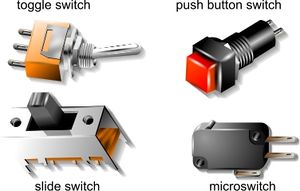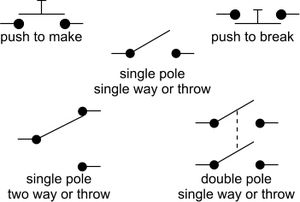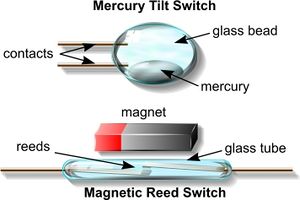Switches: Difference between revisions
From DT Online
mNo edit summary |
(Added Template) |
||
| Line 1: | Line 1: | ||
[[File:Switches1.jpg|300px|right]] | [[File:Switches1.jpg|300px|right]] | ||
__TOC__ | |||
=====Description===== | |||
[http://en.wikipedia.org/wiki/Switch '''Switches'''] are used to make or break an electrical circuit. They can also be used to divert the current path into one of two or more directions ''(ways or throws)'', and can also switch more than one circuit at once. | |||
For example, a double pole double throw switch ''(DPDT)'' can be used as either an ‘on/off’ or ‘changeover’ switch controlling two circuits at the same time. | |||
=====Features and Applications===== | |||
'''Types of switch''' | '''Types of switch''' | ||
| Line 21: | Line 24: | ||
* Switches which can operate two circuits ''(‘double pole’)'' may also be single throw ''(DPST)'' or ‘double throw’ ''(DPDT)'' - DPDT swiches are often used as a reversing switch. | * Switches which can operate two circuits ''(‘double pole’)'' may also be single throw ''(DPST)'' or ‘double throw’ ''(DPDT)'' - DPDT swiches are often used as a reversing switch. | ||
| Line 29: | Line 30: | ||
* The reed switch consists of a pair of contacts in a sealed glass envelope. The contacts may be normally open, closing when a magnet is brought near, or normally closed and opening when a magnetic field is applied. | * The reed switch consists of a pair of contacts in a sealed glass envelope. The contacts may be normally open, closing when a magnet is brought near, or normally closed and opening when a magnetic field is applied. | ||
| Line 39: | Line 35: | ||
* A rotary switch operates with a twisting motion of the operating handle with at least two positions but may have multiple levels or ‘decks’ in order to allow it to control multiple circuits. | * A rotary switch operates with a twisting motion of the operating handle with at least two positions but may have multiple levels or ‘decks’ in order to allow it to control multiple circuits. | ||
<div style="clear: both;"></div> | |||
{{Switches Buyers Guide}} | |||
Latest revision as of 12:04, 3 July 2016
Description
Switches are used to make or break an electrical circuit. They can also be used to divert the current path into one of two or more directions (ways or throws), and can also switch more than one circuit at once.
For example, a double pole double throw switch (DPDT) can be used as either an ‘on/off’ or ‘changeover’ switch controlling two circuits at the same time.
Features and Applications
Types of switch
The symbols show some of the various different switches available:
- Simple push button switches can be either ‘normally open’ (NO) and are pushed to connect or ‘make’ the circuit; or ‘normally closed’ (NC) and are pushed to disconnect or ‘break’ the circuit. Their operation is mommentary.
- Toggle switches provide a continuous ‘on’ or ‘off’. A switch with contacts (or ‘poles’) which can operate only one circuit and has only one switched position (or ‘throw’) is known as ‘single pole single throw’ (SPST).
- A switch with a single common pole but two switched positions (SPDT) is also known as a ‘changeover’ switch. Sometimes there is also a centre ‘off’ position
- Switches which can operate two circuits (‘double pole’) may also be single throw (DPST) or ‘double throw’ (DPDT) - DPDT swiches are often used as a reversing switch.
- The mercury tilt switch consists of a drop of mercury inside a glass bulb with 2 or more contacts. The two contacts pass through the glass, and are connected by the mercury when the bulb is tilted to make the mercury roll on to them.
- The reed switch consists of a pair of contacts in a sealed glass envelope. The contacts may be normally open, closing when a magnet is brought near, or normally closed and opening when a magnetic field is applied.
- A rotary switch operates with a twisting motion of the operating handle with at least two positions but may have multiple levels or ‘decks’ in order to allow it to control multiple circuits.












